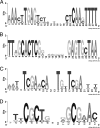An interactive regulatory network controls stress response in Bifidobacterium breve UCC2003
- PMID: 19734308
- PMCID: PMC2772463
- DOI: 10.1128/JB.00897-09
An interactive regulatory network controls stress response in Bifidobacterium breve UCC2003
Abstract
Members of the genus Bifidobacterium are gram-positive bacteria that commonly are found in the gastrointestinal tract (GIT) of mammals, including humans. Because of their perceived probiotic properties, they frequently are incorporated as functional ingredients in food products. From probiotic production to storage and GIT delivery, bifidobacteria encounter a plethora of stresses. To cope with these environmental challenges, they need to protect themselves through stress-induced adaptive responses. We have determined the response of B. breve UCC2003 to various stresses (heat, osmotic, and solvent) using transcriptome analysis, DNA-protein interactions, and GusA reporter fusions, and we combined these with results from an in silico analysis. The integration of these results allowed the formulation of a model for an interacting regulatory network for stress response in B. breve UCC2003 where HspR controls the SOS response and the ClgR regulon, which in turn regulates and is regulated by HrcA. This model of an interacting regulatory network is believed to represent the paradigm for stress adaptation in bifidobacteria.
Figures



Similar articles
-
Intertwinement of stress response regulons in Bifidobacterium breve UCC2003.Gut Microbes. 2010 Mar;1(2):100-102. doi: 10.4161/gmic.1.2.11477. Epub 2010 Feb 11. Gut Microbes. 2010. PMID: 21326917 Free PMC article.
-
A conserved two-component signal transduction system controls the response to phosphate starvation in Bifidobacterium breve UCC2003.Appl Environ Microbiol. 2012 Aug;78(15):5258-69. doi: 10.1128/AEM.00804-12. Epub 2012 May 25. Appl Environ Microbiol. 2012. PMID: 22635988 Free PMC article.
-
The ClgR protein regulates transcription of the clpP operon in Bifidobacterium breve UCC 2003.J Bacteriol. 2005 Dec;187(24):8411-26. doi: 10.1128/JB.187.24.8411-8426.2005. J Bacteriol. 2005. PMID: 16321946 Free PMC article.
-
Bifidobacterium breve UCC2003 surface exopolysaccharide production is a beneficial trait mediating commensal-host interaction through immune modulation and pathogen protection.Gut Microbes. 2012 Sep-Oct;3(5):420-5. doi: 10.4161/gmic.20630. Epub 2012 Jun 20. Gut Microbes. 2012. PMID: 22713271 Review.
-
Genomics and ecological overview of the genus Bifidobacterium.Int J Food Microbiol. 2011 Sep 1;149(1):37-44. doi: 10.1016/j.ijfoodmicro.2010.12.010. Epub 2010 Dec 28. Int J Food Microbiol. 2011. PMID: 21276626 Review.
Cited by
-
How do bifidobacteria counteract environmental challenges? Mechanisms involved and physiological consequences.Genes Nutr. 2011 Aug;6(3):307-18. doi: 10.1007/s12263-010-0207-5. Epub 2011 Jan 13. Genes Nutr. 2011. PMID: 21484166 Free PMC article.
-
Microencapsulation in Alginate and Chitosan Microgels to Enhance Viability of Bifidobacterium longum for Oral Delivery.Front Microbiol. 2016 Apr 19;7:494. doi: 10.3389/fmicb.2016.00494. eCollection 2016. Front Microbiol. 2016. PMID: 27148184 Free PMC article.
-
Accessing the inaccessible: molecular tools for bifidobacteria.Appl Environ Microbiol. 2012 Aug;78(15):5035-42. doi: 10.1128/AEM.00551-12. Epub 2012 May 11. Appl Environ Microbiol. 2012. PMID: 22582076 Free PMC article. Review.
-
Discovering novel bile protection systems in Bifidobacterium breve UCC2003 through functional genomics.Appl Environ Microbiol. 2012 Feb;78(4):1123-31. doi: 10.1128/AEM.06060-11. Epub 2011 Dec 9. Appl Environ Microbiol. 2012. PMID: 22156415 Free PMC article.
-
Transcriptional control of central carbon metabolic flux in Bifidobacteria by two functionally similar, yet distinct LacI-type regulators.Sci Rep. 2019 Nov 28;9(1):17851. doi: 10.1038/s41598-019-54229-4. Sci Rep. 2019. PMID: 31780796 Free PMC article.
References
-
- Andersen, M. T., L. Brondsted, B. M. Pearson, F. Mulholland, M. Parker, C. Pin, J. M. Wells, and H. Ingmer. 2005. Diverse roles for HspR in Campylobacter jejuni revealed by the proteome, transcriptome and phenotypic characterization of an hspR mutant. Microbiology 151:905-915. - PubMed
-
- Bailey, T. L., and C. Elkan. 1995. The value of prior knowledge in discovering motifs with MEME. Proc. Int. Conf. Intell. Syst. Mol. Biol. 3:21-29. - PubMed
-
- Bellier, A., M. Gominet, and P. Mazodier. 2006. Post-translational control of the Streptomyces lividans ClgR regulon by ClpP. Microbiology 152:1021-1027. - PubMed
-
- Bi, C., and C. J. Benham. 2004. WebSIDD: server for predicting stress-induced duplex destabilized (SIDD) sites in superhelical DNA. Bioinformatics 20:1477-1479. - PubMed
Publication types
MeSH terms
Substances
LinkOut - more resources
Full Text Sources

